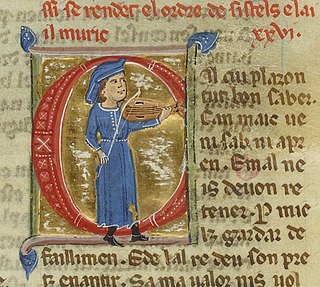
A troubadour was a composer and performer of Old Occitan lyric poetry during the High Middle Ages (1100–1350). Since the word troubadour is etymologically masculine, a female troubadour is usually called a trobairitz.

Peire Cardenal was a troubadour known for his satirical sirventes and his dislike of the clergy. Ninety-six pieces of his remain, a number rarely matched by other poets of the age.

Gaucelm Faidit was a troubadour, born in Uzerche, in the Limousin, from a family of knights in service of the count of Turenne. He travelled widely in France, Spain, and Hungary. His known patrons include Geoffrey II, Duke of Brittany and Dalfi d'Alvernha; he was at one time in Poitiers at the court of Richard I of England, for whose death he wrote a famous planh (lament) in 1199. It is possible, but controversial, that Gaucelm took part in the Third Crusade from 1189–1191; it seems clear that in 1202 he set out on the Fourth Crusade, as did his current patron, Boniface of Montferrat. After 1202 there is no further historical trace of him.

Peire Vidal was an Old Occitan troubadour. Forty-five of his songs are extant. The twelve that still have melodies bear testament to the deserved nature of his musical reputation.
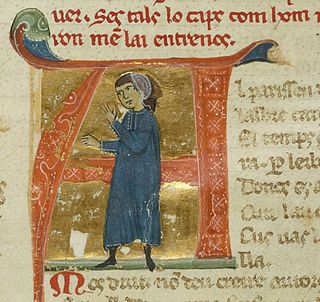
Peire Rogier was a twelfth-century Auvergnat troubadour and cathedral canon from Clermont. He left his cathedral to become a travelling minstrel before settling down for a time in Narbonne at the court of the Viscountess Ermengard. His life and career are known because his late thirteenth-century vida survives, as well as some of his works. The reliability of his vida, upon which all the details of his goings and comings are known, however, is not complete. According to it, he left the religious life to become a jongleur.

The (Lo) Monge de Montaudon, born Pèire de Vic, was a nobleman, monk, and troubadour from the Auvergne, born at the castle of Vic-sur-Cère near Aurillac, where he became a Benedictine monk around 1180. According to his vida, he composed "couplets while he was in the monastery and sirventes on subjects that were popular in the region."

Bertolome Zorzi was a Venetian nobleman, merchant, and troubadour. Like all Lombard troubadours, he composed in the Occitan language. Eighteen of his works survive.

Peire d'Alvernhe or d'Alvernha was an Auvergnat troubadour with twenty-one or twenty-four surviving works. He composed in an "esoteric" and "formally complex" style known as the trobar clus. He stands out as the earliest troubadour mentioned by name in Dante's Divine Comedy.
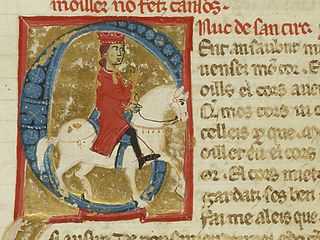
Uc de Saint Circ or Hugues (Hugh) de Saint Circq was a troubadour from Quercy. Uc is perhaps most significant to modern historians as the probable author of several vidas and razos of other troubadours, though only one of Bernart de Ventadorn exists under his name. Forty-four of his songs, including fifteen cansos and only three canso melodies, have survived, along with a didactic manual entitled Ensenhamen d'onor. According to William E. Burgwinkle, as "poet, biographer, literary historian, and mythographer, Uc must be accorded his rightful place as the 'inventor' (trobador) of 'troubadour poetry' and the idealogical trappings with which it came to be associated."
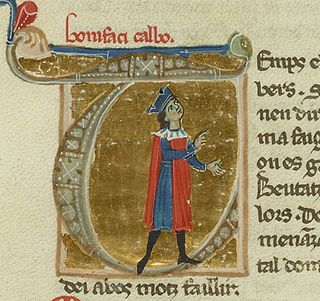
Bonifaci, Bonifatz, or Bonifacio Calvo was a Genoese troubadour of the late thirteenth century. The only biographical account of his life is found in the vida of Bertolome Zorzi. He is, however, the most notable Genoese troubadour after Lanfranc Cigala. In total, nineteen of his poems and two descorts have survived.

Uc Brunet, Brunec, or Brunenc was a nobleman and troubadour from Rodez in the Rouergue. Six of his works survive.

Giraut or Guiraut de Calanso or Calanson was a Gascon troubadour in the Occitan language. Of his lyric works that remain five are cansos, two descorts, a congé, a planh, and a vers. He also wrote a mock ensenhamen entitled Fadet juglar.

Peire Raimon de Tolosa was a troubadour from the merchant class of Toulouse. He is variously referred to as lo Viellz and lo Gros, though these are thought by some to refer to two different persons. On the other hand, lo Viellz could refer to his being of an early generation of troubadours. Eighteen of Peire Ramon's poems survive, one canso with a melody.

Elias de Barjols was a bourgeois Aquitainian troubadour who established himself in Provence and retired a monk. Eleven of his lyrics survive, but none of his music.
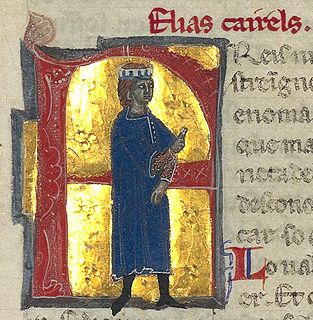
Elias Cairel was a troubadour of international fame. Born in Sarlat in the Périgord, he first travelled with the Fourth Crusade and settled down in the Kingdom of Thessalonica at the court of Boniface of Montferrat (1204–1208/10) before moving back to western Europe, where he sojourned at the court of Alfonso IX of León (1210–11) and in Lombardy (1219–1222/24). He wrote fourteen surviving lyrics: ten cansos, one tenso, one descort, one sirventes, and one Crusade song. He was partial to refrain rhyming and coblas capfinidas.

Guillem or Guilhem Magret was a troubadour and jongleur from the Viennois. He left behind eight poems, of which survive a sirventes and a canso with melodies.

Pistoleta was a Provençal troubadour. His name means "little letter (epistle)" in Occitan. He left behind eleven songs, comprising nine cansos and two tensos. Some of his pieces are assigned to an otherwise unknown Jordan de Born in the table of contents of chansonnier C, a fourteenth-century Occitan manuscript.

Guilhem Ademar was a troubadour from the Gévaudan in France. He travelled between the courts of Albi, Toulouse, Narbonne, and Spain. He achieved fame enough during his life to be satirised by the nobleman and monk, Monge de Montaudon. Guilhem entered holy orders towards the end of his life. Sixteen poems—fourteen cansos, a sirventes, and a partimen with Eble d'Ussel—form his surviving corpus. His cansos are his most famous pieces. Usually humorous, several mock the poetry of Ademar's more illustrious contemporary Arnaut Daniel. One canso survives with a tune.

Garsenda was the Countess of Provence as the wife of Alfonso II from 1193 and the Countess of Forcalquier in her own right from 1209 and subsequently united with Provence. She was also a patron of Occitan literature, especially the troubadours, and herself wrote some lyric poetry and is counted among the trobairitz as Garsenda de Proensa. She was, in the words of her most recent editors, "one of the most powerful women in Occitan history".
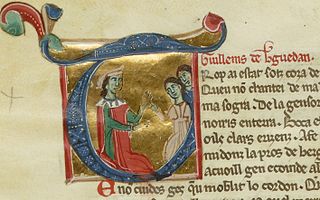
Guillem de Berguedà, or Guilhem de Berguedan in Occitan, was a Catalan troubadour and viscount of Berguedà. He was the most prolific Catalan poet of the twelfth century, though he composed in Occitan, and thirty-one of his poems survive. Most are sirventes, "typically violent and obscene, reflecting his character and turbulent life," but there are a few cansos. Most of what is known about him derives from his vida and his songs.




















